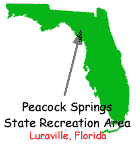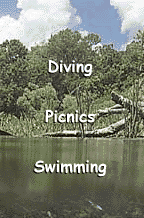
Reservations for
Florida State
Parks are now
made through
Reserve America,
toll free, at
1-800-326-3521
|
PEACOCK
SPRINGS STATE RECREATION AREA
About 1,000
years ago this island was pushed up from the Gulf floor to rest on a limestone
platform. Its geologic growth hasn't stopped. Recent research has documented
a 30 percent increase in the size of this platform since 1957. Peacock
Springs State Recreation Area is an outstanding natural ecosystem containing
elements of statewide and national significance.
Excellent examples of surface
and subsurface karst limestone features, including two major springs, a
major spring run, six sinkholes and numerous small sinks and depressions,
can be found in the 252-acre recreation area.
UNDERWATER CAVES
When seepage and the flow of subsurface streams causes the roof of underground
caverns to dissolve and collapse, springs and sinks are formed. The thin
mantle of sandy sediments covering the caverns are then eroded and carried
off by the subsurface streams, forming a diverse landscape of sinks and
depressions. The sinkholes and springs found here are in nearly pristine
condition and are part of the most extensive underwater cave system known
in Florida. It is also one of the longest underwater cave systems in the
entire continental United States, with about 28,000 feet of passages having
been explored and surveyed by cave divers.
The two major springs, Peacock
and Bonnet, are third magnitude springs and are tributaries of the Suwannee
River via Peacock Slough. In addition to the two major springs certified
cave divers also use Orange Grove sink to enter the vast interconnected
underwater cave system.
WARNING!
BE WARNED: MANY PERSONS HAVE BEEN INVOLVED IN DIVING ACCIDENTS HERE AND
MANY HAVE DIED. It is the policy of the Florida Park Service (FPS) to prohibit
open water divers from carrying lights or entering the cave system. Solo
diving is prohibited.
The sinks and cave system provide
critical habitat for at least three endangered or threatened species of
cave crustaceans: cave crayfish, Florida cave amphipod and Hobb cave amphipod.
PLANT LIFE
In addition to the outstanding quality of the aquatic cave system, the upland
area contains mature forest stands representing four major natural plant
communities: xerotic hammock, upland hardwood forest, bottomland forest
and floodplain swamp. A canopy of sand live oak, laurel oak, pignut hickory
and southern magnolia can also be found in the hammock. The upland forest
is dominated by Florida maple, American holly and dogwood in addition to
laurel oak and pignut hickory. The bottomland forest is known for mature
second growth and old growth characterized by oak, water hickory, red maple,
sweetgum, loblolly pine and cedar elm, a state endangered species. An open
canopy of bald cypress over a dense sub-canopy of pop ash, swamp privet
and button ash characterizes the swamp.
ACTIVITIES
Visitors will enjoy picnicking in the main use areas of
Peacock Springs.
Swimming is
limited to Peacock Springs and Orange Grove Springs dependent on the seasonal
water levels. Visitors may swim and dive at their own risk. There are no
lifeguards.

Peacock
Springs State Recreation Area is located 16 miles southwest of Live
Oak on S.R. 41, two miles east of Luraville on Peacock Springs Road.
For more information, contact Peacock Springs State Recreation Area
c/o Ichetucknee Springs State Park
Route 2, Box 108
Fort White, Florida 32038
(904)497-2511.
View Larger Map |
|



